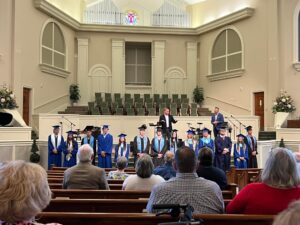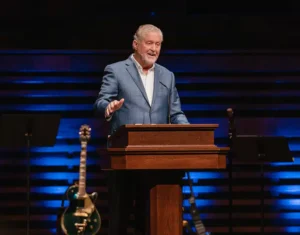
WACO, Texas (BP)–Baylor University President Robert B. Sloan Jr. and Baylor Board of Regents chairman Will Davis jointly announced Jan. 21 that Sloan will transition to chancellor of the largest Baptist University in the world effective June 1.
“It has been my privilege to launch the university upon the exciting journey we call Baylor 2012. Now that the voyage is well under way, it is time for someone new to navigate sometimes choppy waters, always aiming toward the fully charted destination ahead,” Sloan said.
During the Jan. 21 news conference, Davis said Baylor regents had expressed unanimous support for the change and are expected to ratify it during their Feb. 3-4 meeting.
“Baylor has been through a challenging period over the past 18 months,” Davis said, “and the Board of Regents and the administration have been actively engaged in discussions over this time period about how best to address these challenges and do what is best for the university.” Davis noted that he and Sloan arrived at the decision by mutual agreement. He said an interim president and a presidential search committee will be appointed later this spring.
Introducing his remarks by stating, “There’s a time and an appointed season for every person under heaven,” Sloan said Baylor University “has touched every season of my life,” referring to his student athlete days, academic career, being the parent of Baylor students and serving as dean of Truett Seminary. “It has been a great privilege to lead this wonderful institution that has meant so much to the church, to the state and to the nation.”
Sloan said every Baylor president inherited a strong foundation, honoring it by accepting the challenge of the future. “In the dynamic field of higher education, the focus must always be on the horizon,” he insisted, anticipating progress toward the Baylor 2012 vision of moving into the upper echelons of American higher education while strengthening its Christian mission.
“Ascending to the top tier of American universities while maintaining our firm commitment to a uniquely Baptist and distinctly Christian identity insures that there is no more exciting place to be in American higher education than right here at Baylor University,” Sloan told reporters. Noting that secularization in America and in academia had been ruled inevitable by most observers, Sloan said Baylor’s pursuit of the 2012 Vision proved that the best of the Christian tradition can be linked with the finest standards of scholarship and teaching.
After recounting significant achievements in a wide range of areas, Sloan admitted, “The natural side effect of change is conflict. We moved quickly and boldly to implement the vision and found that Baylor is not immune to the discomfort and insecurity generated by change.” He declared that his own leadership “has often been a lightning rod for that discomfort,” insisting the focus be placed on the vision.
“Though I’ve worked hard to cultivate mutual understanding with those that disagree with various decisions or even my management style, the reality is my role as president has become more of a distraction from the main goal of fulfilling the vision,” Sloan stated.
Stating that the university, its purpose and its vision are more important than any one person, Sloan expressed confidence in Davis’ leadership and the Board of Regents in pursuing the vision of Baylor 2012. “It’s an opportunity for someone who has fresh political capital and a clean slate to take that forward.”
Responding to a reporter who questioned the president’s earlier pronouncement that he would not resign, Sloan said he and Davis had discussed “this possible change” as early as last November. “I would just say I have adamantly maintained I would stay committed to Baylor University and 2012. As you said, I said I will not quit. I am continuing to serve Baylor University in a different capacity.”
Sloan said the reason he wanted to continue as president as long as he did was because he was persuaded that was in the best interest of Baylor. “Now I’m persuaded it’s in the best interest of Baylor that the university have the opportunity for new leadership.”
He declined to identify for a reporter the particular decisions that he might have made differently, stating, “Life is full of decisions. That’s what leaders have to do — take the best information you have at the moment and react out of the values you possess. Sometimes it’s intuitive and sometimes you work a long time before coming to a decision. There are always things you would do differently in retrospect,” Sloan said, adding, “I have absolutely no regrets about the core commitments and decisions over the years with respect to Baylor.”
Sloan said he is enthusiastic about his last 130 days as president and the opportunity to represent Baylor as chancellor. He outlined his new assignment as involving fundraising, student recruitment, networking with higher education leaders on the state and national levels, cultivating Baylor’s relationships with denominational and Christian leaders and organizations, while continuing to promote the Baylor 2012 vision to constituents.
The tenured professor of religion and founding dean of George W. Truett Theological Seminary assumed the Baylor presidency on June 1, 1995. Over the past decade the Baylor alumnus has presided over significant academic, physical, financial and reputational expansion, according to a news release issued by the university.
The Baylor president survived repeated challenges to his leadership, mostly from the Faculty Senate and the Baylor Alumni Association, a group that compared Sloan unfavorably with former Baylor President Herb Reynolds. Last December, the Faculty Senate, via a faculty referendum, delivered a third no-confidence vote in a 14-month period, tallying 414 votes against Sloan, although only 59 percent of the eligible faculty voted, leaving 400 who chose not to participate, according to a faculty group that protested continued calls by Sloan’s opponents for his dismissal. The Board of Regents affirmed Sloan last fall by a 31-4 vote, much stronger than the 18-17 decision against the call for him to resign last May.
Davis conveyed his support of Sloan’s leadership, stating, “He led Baylor through a period of bold changes as we have sought to position the university as a leader in higher education and strengthen its mission.” Insisting that a change in leadership does not indicate any movement away from the Baylor 2012 vision endorsed by the regents in 2001, Davis said, “Baylor’s direction in going forward continues to be 2012. Naturally, this will be adjusted to reflect the realities of the time,” Davis said, referring to financial conditions, then adding, “Baylor 2012 remains our blueprint for the future.”
The 10-year vision calls for Baylor to become a nationally prominent research institution while simultaneously strengthening its Christian mission. Davis said, “I believe if you look back over the last decade, you will see ample evidence that President Sloan has led Baylor through a period of tremendous growth and progress. Anyone who walks across this campus or talks to faculty, staff, students, parents, donors and alumni, or to higher education leaders across the nation will see and hear tangible expressions of the progress made under President Sloan.”
Student Body Association President Jeff Leach offered strong appreciation of Sloan in a prepared statement released to the media. “Many lives have been changed at Baylor as a result of the unashamed, unapologetic and unwavering commitment to our mission ‘to educate men and women for worldwide leadership and service by integrating academic excellence and Christian commitment within a caring community,'” Leach stated.
“I will be eternally grateful for the impact that Dr. Sloan has had on my life and I know I speak for thousands of current students and graduates when I express my heartfelt gratitude for his service to our university,” Leach added. “Minds have been challenged, leaders have been raised up and lives have been changed because of Dr. Sloan and his leadership.” Leach said the student body stands behind Davis and the Board of Regents, “confident that Baylor will continue to be a city on a hill and will become an even brighter light to the world in the coming days as we unite and move forward together.”
Chartered in 1845 by the Republic of Texas and affiliated with the Baptist General Convention of Texas, Baylor is the oldest institution of higher learning in the state and the largest Baptist university in the world. Fall enrollment at the Waco campus hit 13,799, an increase of 14 percent since Sloan began serving a decade ago, with a freshman class that is the most diverse in the school’s history as minority enrollment jumped to 30.3 percent.
The school offers 164 baccalaureate degree programs at the undergraduate level, 23 master’s degrees with 74 programs of study, one educational specialist and 19 doctoral degree programs through the graduate school plus the juris doctor through the law school and the master of divinity, master of divinity/master of music and doctor of ministry through George W. Truett Theological Seminary. During Sloan’s tenure, a new science and math building was among numerous improvements on campus, which increased in acreage from 450 to nearly 750 on the banks of the Brazos River.
According to Baylor, almost half of the 780 fulltime faculty have been hired under the Sloan administration, growing from 644 in 1995 to 780 in 2004. Annual expenditures for research and other sponsored activity have more than tripled over the past decade, growing from $2.6 million to $8.9 million.
Annual gifts to the university have grown from $18.5 million in 1995 to more than $45 million in 2003, the university’s fourth-best giving year, according to a Baylor source, with more than 3,500 first-time donors. Gifts to the university during the Sloan administration total almost $400 million. Endowment has almost doubled, from $341 million in 1996 to $722 million in 2004. The university’s operating budget has more than doubled, from $145 million in 1995-96 to more than $340 million in 2004-05.
–30–















